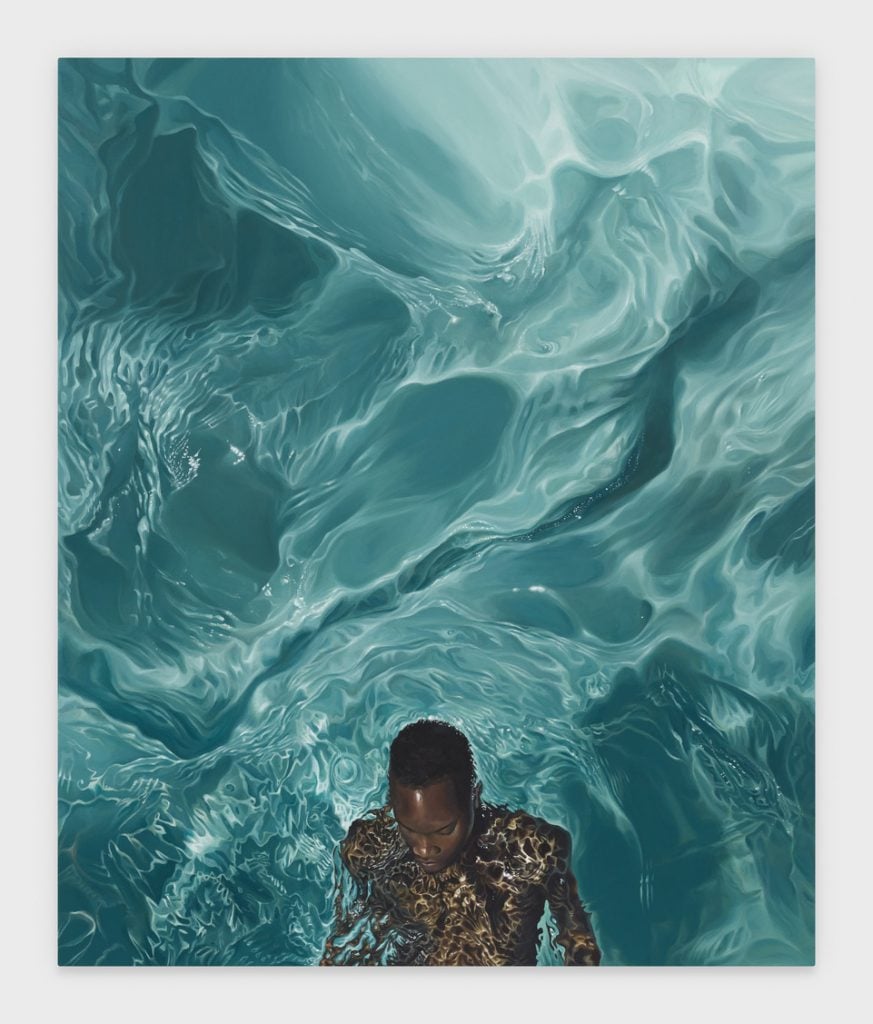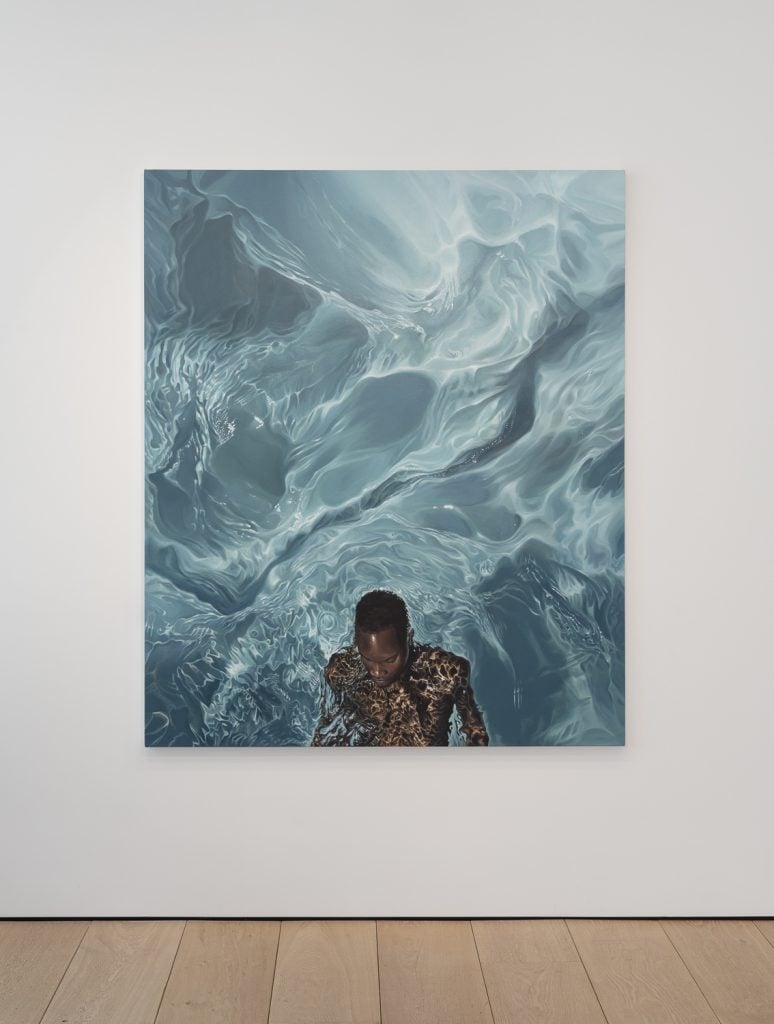Art Criticism
Roxane Gay on How Artist Calida Rawles Shows Us a New, and More Humane, Way of Bearing Witness
The writer explores the significance Rawles's painting "High Tide, Heavy Armor."

The writer explores the significance Rawles's painting "High Tide, Heavy Armor."

Roxane Gay

On September 23rd, 2020, Kurt Reinhold was stopped by police for jaywalking in San Clemente, California. As is all too often the case when Black people deal with law enforcement, Reinhold did not survive what should have been a routine encounter. And by that, I mean he was murdered by two police officers whose greatest fears are, seemingly, embodied by Blackness. It is important to be clear about this kind of atrocity, to use language plainly and directly, to place culpability where it belongs—in the bloodied hands of people who were supposed to serve and protect.
Kurt Reinhold was 42 years old. He was a father to two children. He was a husband. He coached soccer. At the time of his passing, he was in and out of homelessness and suffering from mental illness. He was human, in the wrong place at the wrong time where everywhere is the wrong place and every hour of every day is the wrong time. In the end, his humanity was a death sentence. He was vulnerable and he was not afforded the compassion or protection he deserved.
Reinhold is one in a long line of Black people who were not granted dignity or due process. I have written about many of the Black people who have lost their lives to police brutality and the ills of white supremacy. Michael Brown. Trayvon Martin. Tamir Rice. Jordan Davis. Freddie Gray. Eric Garner. Atatiana Jefferson. Sandra Bland. Alton Sterling. Philando Castile. Rayshard Brooks. Botham Jean. Breonna Taylor. George Floyd. Daunte Wright. Ma’Khia Bryant. There is always a new name to add to the list. There is always another Black life lost under unfathomably tragic circumstances.
Each time I write about a life taken too soon and so callously, I wonder how much longer I will have to participate in this merciless cycle of raging against and mourning and lamenting the fragility of Black life. I wonder if I will ever stop worrying about my Black father, my Black brothers, my Black nieces and nephew, or even myself. There is a point where language feels inadequate or where language is exhausted, when there is nothing more to be said about this national disgrace. Sometimes, I worry I have reached the limits of language and if there is nothing more that can be said, there may well be nothing more that can be done to prevent these extrajudicial murders from happening.

Calida Rawles, High Tide, Heavy Armor (2021). Courtesy the artist and Lehmann Maupin, New York, Hong Kong, Seoul, and London
Most of the contemporary images we have of Black suffering are taken by bystanders with cell phones—people who are in the wrong place at the wrong time, but have the wherewithal to photograph and record video of the crimes they are witnessing. While police brutality is not new, having so much documented evidence of these crimes is. And just as I feel I have reached the limits of language when it comes to police violence against Black people, there are times when I am certain we have, as a culture, also exhausted the limits of visual language. We have this documentation, but it is never a deterrent for police officers. Time and again, we watch horrifying videos where police act with impunity even when they know they’re being watched. We are left with the trauma not only of bearing witness, but also of knowing that there is little justice to be found.
It was, in fact, this pervasive imagery of Black suffering that gave rise to the Black Lives Matter movement and has sustained a vigorous demand for change over the past several years. The international protests in the wake of George Floyd’s murder were fueled by the inescapability of a nearly nine-minute video of a Black man being suffocated to death beneath the knee of a white police officer who stared into the camera, practically daring a bystander to stop him. In this instance, people were moved to care because they had irrefutable evidence of Black suffering and grave injustice. But we’ve seen such evidence many times. There is an outcry and there is hand-wringing, there are some protests, and then the status quo resumes.
Historically, white people in particular have needed visual evidence to recognize Black humanity and to be moved to action. In her book Humane Insight: Looking at Images of African American Suffering and Death, about the history of visual narratives of Black suffering, Courtney R. Baker notes that, “There was a significant drive among both Black and white antislavery advocates to make the wounds of slavery more accessible to a public in need of a sensorial understanding of slavery’s ills.”
It was fairly common for formerly enslaved people to bare the thick braids of their scars at abolitionist gatherings. Their testimony was not enough. The material realities of slavery were not enough. White people, mostly, needed to witness something visceral to truly feel the extent of slavery’s wrongness.
After the end of the slavery era, there were the images on lynching postcards (though they were created as appalling souvenirs, they still documented an unparalleled brand of brutality). There was Mamie Till allowing her slain son Emmett Till’s casket to remain open so people could see what had been done to her child. We have seen the haunting images from the Jim Crow era. We have seen the fiery images of the civil rights protests of the 1960s. Today, we have the images of victims of police brutality and passionate protests reminding the world that black lives matter.
![Calida Rawles, High Tide, Heavy Armor [detail] (2021). Courtesy the artist and Lehmann Maupin, New York, Hong Kong, Seoul, and London](https://news.artnet.com/app/news-upload/2021/10/CR-LM32322-High-Tide-Heavy-Armor-det02select-683x1024.jpg)
Calida Rawles, High Tide, Heavy Armor [detail] (2021). Courtesy the artist and Lehmann Maupin, New York, Hong Kong, Seoul, and London
Given how ubiquitous images of Black suffering have become, I sometimes feel like bearing witness renders tragedy into spectacle. It is grotesque to watch people being shot, bodies lying in the street, police in military gear bearing down on protestors exercising their legal right to demand. It is traumatizing. There is a point when it is all too much. I am well past that point and I know I am not alone in that. There has to be a different way to make sense of such tragedies.
When I first saw Calida Rawles’s 2021 painting High Tide, Heavy Armor, I felt, as I often do when I am experiencing great art, that she was offering a different way of bearing witness. In the painting, a Black man floats in crystal blue water. The photorealism of the painting is uncanny—the smoothness and glowing brown of the man’s skin, the range of blues of the water, the reflection of the sun.
The man is bare-chested, looking down, eyes closed. The waves surrounding his body embrace him. He appears vulnerable but safe in that vulnerability. There is no one near him to question or challenge his right to be in these waters. He doesn’t have to justify or explain his leisure. The water and his solitude are a shield from whatever troubles he might find on land. The tide is high, but heavy armor will keep him safe. Or, I suppose, that is how I choose to understand the painting. That’s how I need to understand the painting.
High Tide, Heavy Armor depicts the kind of image of Black men we see all too rarely. It offers an alternative way of remembering. Rawles created this painting as a visual elegy for Kurt Reinhold, who was a father at her daughter’s day care. The world really is that small.
There is complexity to the image. In the upper right-hand corner, where the waters are more turbulent, Rawles has crafted the undulations of that water referencing topographical maps of cities where Black lives have been tragically lost—San Clemente, for Kurt Reinhold, but also Minneapolis, Chicago, Atlanta, Baton Rouge, Seattle, Columbus, Staten Island, Louisville, and others. This topographical mapping is subtle but powerful. Whether the viewer is aware of the mapping or not, it is there, as an ever-present reminder of the many places where Black lives have not mattered in the ways they should.
![Calida Rawles, High Tide, Heavy Armor [detail] (2021). Courtesy the artist and Lehmann Maupin, New York, Hong Kong, Seoul, and London](https://news.artnet.com/app/news-upload/2021/10/CR-LM32322-High-Tide-Heavy-Armor-det01select-1024x683.jpg)
Calida Rawles, High Tide, Heavy Armor [detail] (2021). Courtesy the artist and Lehmann Maupin, New York, Hong Kong, Seoul, and London
And that’s why High Tide, Heavy Armor affects me so profoundly. It is a stunning artwork that can be read in a multitude of ways, but no matter how one chooses to engage with the painting, the work honors and communicates the realities of Black life, and does so in unexpected but original ways. It gives me a small measure of hope to think that there are alternative ways of contributing to the visual narrative of Black life, ways that acknowledge trauma without relying on explicit images of that trauma to tell the necessary stories of our lives.
“Calida Rawles: On the Other Side of Everything” is on view at Lehmann Maupin, New York, through October 23.
Roxane Gay is a writer, editor and educator. She is the author of the books Bad Feminist, Hunger, Difficult Women, and others. She loves art.